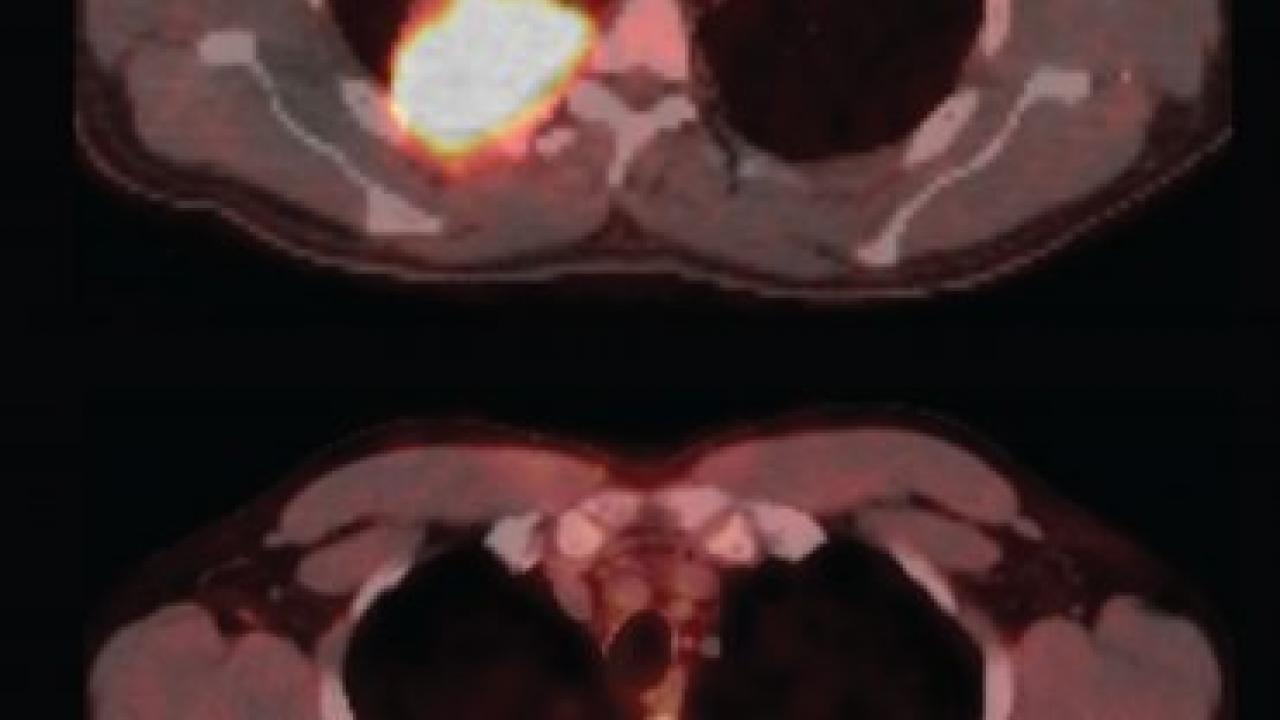
PET-CT imaging from a patient with EGFR-mutant lung cancer before (top) and after (bottom) treatment with the targeted drug erlotinib (Tarceva). By studying the residual tumor seen in the lower image, a UCSF team determined why the patient developed erlotinib resistance, and devised a strategy to overcome it. Image from Blakeley et al., Cell Communications, April 2, 2015.
Capitalizing on a rare opportunity to thoroughly analyze a tumor from a lung cancer patient who had developed resistance to targeted drug treatment, UC San Francisco scientists identified a biological escape hatch that explains the resistance, and developed a strategy in mice for shutting it down.
In experiments that combined the drug the patient had taken with a second compound that blocks off this newly discovered resistance pathway, the researchers were able to durably wipe out cancer cells in mice implanted with cells from the drug-resistant tumor.
“Even in cancers that are responding to targeted therapy by conventional criteria, resistance is already developing,” said the senior author of the new study, Trever Bivona, MD, PhD, assistant professor of medicine and member of the UCSF Helen Diller Family Comprehensive Cancer Center (HDFCCC). “In this work we have begun to crack open the question of why residual disease persists after targeted therapy.”
Between 10 and 35 percent of non-small cell lung cancer (NSCLC) patients carry mutations in a gene that codes for a cell-surface protein called the epidermal growth factor receptor, or EGFR. As its name suggests, under normal circumstances, when a growth factor protein locks onto the EGFR, the receptor sends signals that prompt cells to divide and proliferate. But the EGFR mutations seen in NSCLC cause the receptor to be stuck in an “on” position, leading to rampant cell proliferation.
Over the past decade, medications such as erlotinib (trade name Tarceva), which precisely targets the EGFR and tamps down its activity, have advanced the treatment of EFGR-mutant NSCLC beyond chemotherapy, but significant challenges remain. As many as 30 percent of patients exhibit so-called primary resistance to EGFR inhibitors, in which the drugs have no detectable effect. And among patients who do respond, almost all have an incomplete response leading to acquired resistance, in which drug-resistant cells that survive treatment form residual, often lethal, tumors.
Understanding the biological basis of acquired resistance has proved difficult, partly because patients with late-stage lung cancer rarely undergo surgery, leaving scientists with few drug-resistant tumors to use in research. But as described in the online edition of Cell Reports on Thursday, April 2, 2015, a team of UCSF researchers recently had unusual access to a surgically resected tumor from an EGFR-mutant lung cancer patient who had experienced a substantial, but incomplete, response to erlotinib.